 "ttyymmnn" (ttyymmnn)
"ttyymmnn" (ttyymmnn)
07/17/2018 at 12:35 • Filed to: wingspan, Planelopnik, TDIAH
 12
12
 14
14
 "ttyymmnn" (ttyymmnn)
"ttyymmnn" (ttyymmnn)
07/17/2018 at 12:35 • Filed to: wingspan, Planelopnik, TDIAH |  12 12
|  14 14 |
!!! UNKNOWN CONTENT TYPE !!!
Welcome to
This Date in Aviation History
, getting of you caught up on milestones, important historical events and people in aviation from July 14 through July 17.
!!! UNKNOWN CONTENT TYPE !!!
 !!!CAPTION ERROR: MAY BE MULTI-LINE OR CONTAIN LINK!!!
!!!CAPTION ERROR: MAY BE MULTI-LINE OR CONTAIN LINK!!!
July 14, 1951 – The first flight of the Lockheed L-1049 Super Constellation. While the history of aviation tends to focus on firsts, it is also a story of evolution as much as revolution. Oftentimes, an aircraft that is designed for a single purpose is developed to fulfill a different role, or a successful design will receives variants to enhance performance or capacity. Such is the story of the L-1049 Super Constellation, which began with the first flight of its !!!error: Indecipherable SUB-paragraph formatting!!! predecessor in 1943.
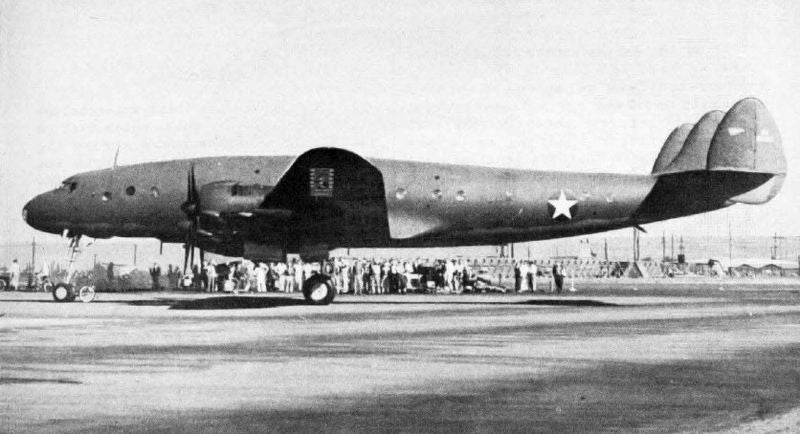
The Lockheed L-049 Constellation prototype in 1943. This aircraft was later transferred to the US Army Air Forces as the C-69. (US Navy)
The Constellation, nicknamed “Connie,” arguably one of the most graceful aircraft ever to take to the skies, started life as a much more plain Jane aircraft, the !!!error: Indecipherable SUB-paragraph formatting!!! , a run of the mill, four-engine transport that never entered production. In 1939, the eccentric billionaire !!!error: Indecipherable SUB-paragraph formatting!!! , owner of Transcontinental & Western Airlines (which would become !!!error: Indecipherable SUB-paragraph formatting!!! ), held a meeting with !!!error: Indecipherable SUB-paragraph formatting!!! , the president of T&WA, along with other Lockheed executives. Among those present was !!!error: Indecipherable SUB-paragraph formatting!!! , who was destined to become one of America’s greatest aviation engineers. Hughes told the Lockheed engineers that the Excalibur wouldn’t meet needs of his airline, and he wanted something entirely new. So Lockheed went back to the drawing board and, in just three weeks time, presented Hughes with the initial plans for the Connie, now designated L-049. The new airliner, powered by a quartet of !!!error: Indecipherable SUB-paragraph formatting!!! radial engines, was the most expensive aircraft produced to date, and Hughes himself funded the purchase of 40 aircraft since T&WA didn’t have the funds to pay for them. The first Connies were pressed into military transport service as the !!!error: Indecipherable SUB-paragraph formatting!!! , but production turned to the civilian market after WWII and the Connie enjoyed a successful airline career, and Lockheed built a total of 865 airliners.
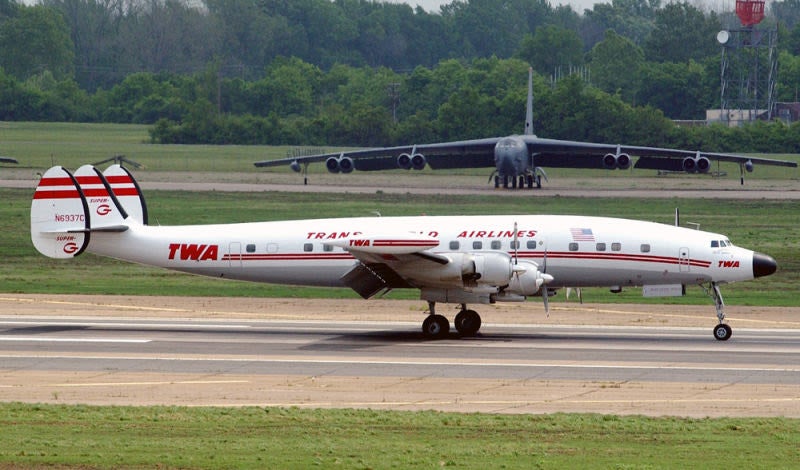 !!!CAPTION ERROR: MAY BE MULTI-LINE OR CONTAIN LINK!!!
!!!CAPTION ERROR: MAY BE MULTI-LINE OR CONTAIN LINK!!!
But as flying became more popular, the airlines needed bigger planes. And Lockheed’s competitors were making strides of their own. In 1950,
!!!error: Indecipherable SUB-paragraph formatting!!!
came out with the
!!!error: Indecipherable SUB-paragraph formatting!!!
, a stretched cargo version of its popular airliner, and were preparing to launch the passenger variant of the DC-6A, the DC-6B, which accommodated 23 more passengers than the Connie. Lockheed had looked into a stretched Constellation, but decided not to build it at the time. However, Douglas’ move forced their hand. Lockheed repurchased the prototype XC-69 Constellation from Hughes Tool Company and lengthened the fuselage by 18 feet, and the newly christened Super Connie now had room up to 106 passengers.
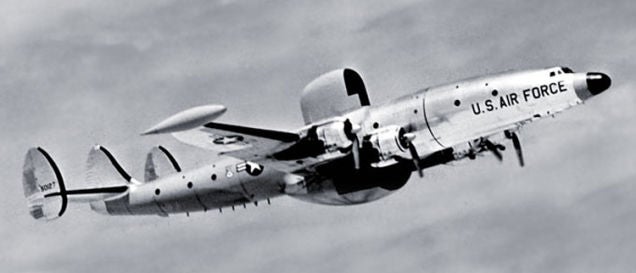
Lockheed EC-121 Warning Star electronic surveillance platform (US Air Force)
As Lockheed continued to develop the Super Connie, they added more powerful !!!error: Indecipherable SUB-paragraph formatting!!! 18-cyliner engines. Compared to the DC-6B, the L-1049 could carry a larger payload, though the Douglas airliner still had a greater range, even when wingtip fuel tanks were added to the Super Connie. Other improvements included strengthened wings and increased cabin soundproofing. A total of 259 of the commercial version were built, and the Super Constellation also saw service with the US Air Force and US Navy, who flew a total of 320 Super Connies. The Air Force version was the !!!error: Indecipherable SUB-paragraph formatting!!! electronic surveillance platform, while the Navy flew the bulk of the military constellations for transport and early warning. Most of the Super Connies were retired with the advent of jet transports such as the !!!error: Indecipherable SUB-paragraph formatting!!! and !!!error: Indecipherable SUB-paragraph formatting!!! , and the last commercial flight of the L-1049 was made by Dominican Airlines in 1993. The last military variant was retired in 1982. Two Super Connies remain airworthy, with a small number of others awaiting or undergoing restoration.
!!! UNKNOWN CONTENT TYPE !!!
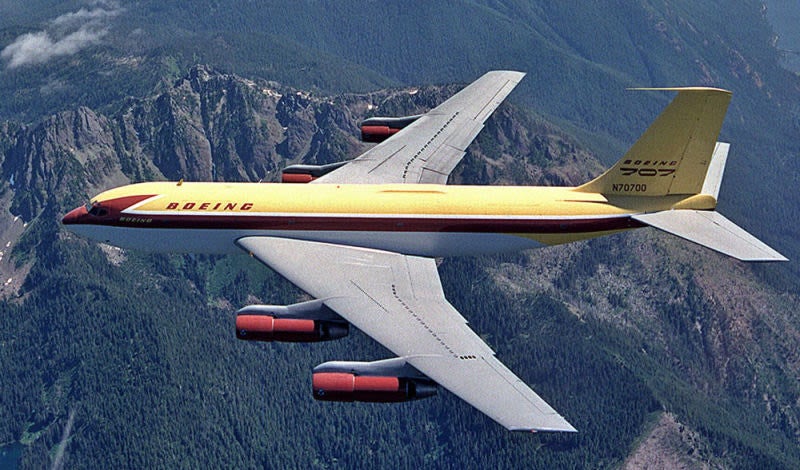
(Boeing)
July 15, 1954 – The first flight of the Boeing Dash 80. By the end of WWII, the turbojet engine was beginning to take over as the powerplant of choice for large airliners. However, that change did not take place overnight. After all, technological developments in large piston-powered aircraft during the war had made them relatively safe and reliable, and airlines were reluctant to try something new when the aircraft they had were working just fine. The first step towards commercial jet aviation was taken by !!!error: Indecipherable SUB-paragraph formatting!!! with their !!!error: Indecipherable SUB-paragraph formatting!!! airliner, which first flew in 1949. And though the Comet eventually found a measure of success, it was very much a product of an earlier era, with wings that were swept only on the leading edge and four engines housed in the wing roots. Boeing, however, was already looking to the future.

The Model 367-80, better known as the Dash 80, is rolled out of Boeing’s facility in Renton, Washington on May 14, 1954. Note the registration N70700. (National Air and Space Museum)
Two years before the first flight of the Comet, Boeing capitalized on German research that had been seized near the end of the war. Armed with data on the benefits of swept wings, Boeing designed the !!!error: Indecipherable SUB-paragraph formatting!!! for the US Air Force with wings swept back at 35 degrees and engines placed in pods suspended from the wings. In doing so, Boeing set the standard for basic airliner design that remains to this day, and the success of the Stratojet inspired Boeing’s foray into the jet airliner business. The international airliner market was still saturated with piston-powered planes, particularly those built by !!!error: Indecipherable SUB-paragraph formatting!!! , and none of the airlines was interested in buying an untested airplane. So Boeing figured that the only way to prove that their airliner concept worked was to build and fly one.
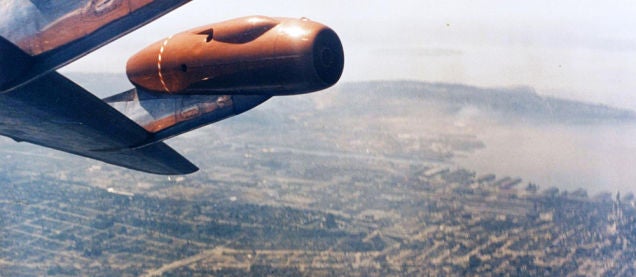
Tex Johnston rolls the Dash 80
Boeing president !!!error: Indecipherable SUB-paragraph formatting!!! took a huge gamble, and invested $16 million of the company’s money into the development of a prototype airliner that they hoped would satisfy the needs of both the airlines and the US Air Force, who was looking for a jet-powered aerial tanker to keep their new jet fighters in the air. Following just two years of development, Boeing rolled out the Model 367-80, or “Dash 80,” from their Renton, Washington factory on May 15, 1954. Since Boeing was pitching the jet to the Air Force, the Dash 80 had large cargo doors and very few windows. Just one week after the first flight, the Air Force ordered 29 aircraft designated as the !!!error: Indecipherable SUB-paragraph formatting!!! . But Boeing still needed to convince the airlines that they had a winner on their hands. In 1955, Allen invited airline executives to Seattle’s Seafair festival to get a look at the Dash 80. In what has become a legendary stunt, Boeing test pilot !!!error: Indecipherable SUB-paragraph formatting!!! , who was supposed to do a simple fly by, instead performed a barrel roll in the Dash 80. He later told Allen that he was just “selling airplanes.”
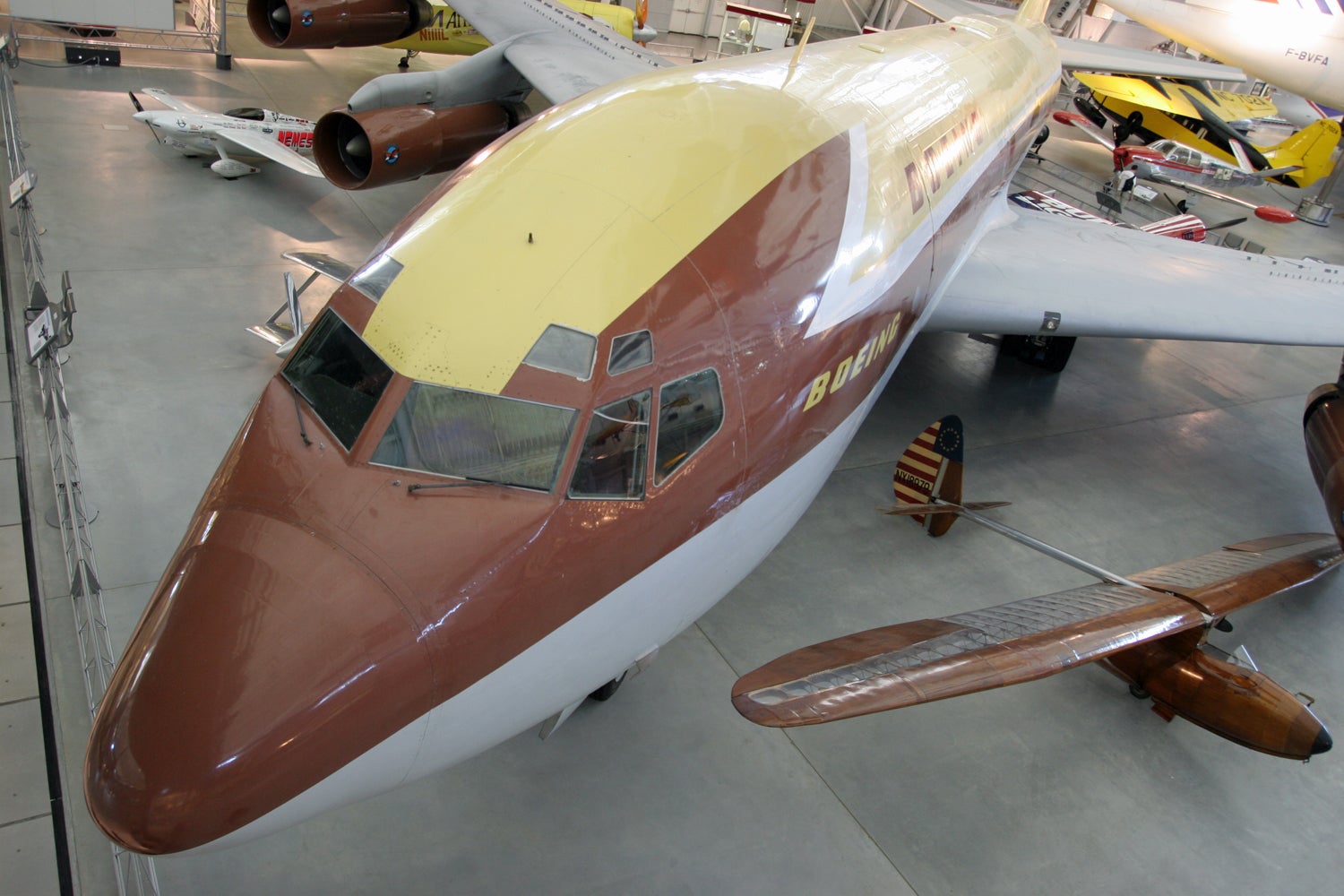
The Dash 80 on display at the Steven F. Udvar-Hazy Center near Washington, DC. (Tim Shaffer)
But the bold move paid off, and Pan Am ordered 20 passenger versions of the Dash 80 (though they hedged their bets and ordered 25 !!!error: Indecipherable SUB-paragraph formatting!!! at the same time). Two years later, the !!!error: Indecipherable SUB-paragraph formatting!!! took its maiden flight. The 707 was longer than the Dash 80 and KC-135, and the fuselage was widened to allow five-abreast seating, which eventually grew to six-across. With the Dash 80, Boeing truly had a runaway hit on their hands, and eventually produced just over 800 KC-135s and just over 1,000 707s. Only one Dash 80 was ever built, and after production of the tanker and airliner began, the Dash 80 was used as a platform for testing components of the upcoming !!!error: Indecipherable SUB-paragraph formatting!!! tri-jet. Following the Dash 80's retirement in 1970, Boeing donated the aircraft the !!!error: Indecipherable SUB-paragraph formatting!!! in 1972, and it sat at the aircraft !!!error: Indecipherable SUB-paragraph formatting!!! at !!!error: Indecipherable SUB-paragraph formatting!!! in Arizona for 18 years. But such a historic aircraft deserved a much better fate, and it was finally restored by Boeing in 1990 and then flown to Washington, DC, where it was enshrined at the Smithsonian’s !!!error: Indecipherable SUB-paragraph formatting!!! in 2003.
!!! UNKNOWN CONTENT TYPE !!!

Apollo 11 lifts off from Kennedy Space Center (NASA)
July 16, 1969 – The launch of Apollo 11. By the early 1960s, the !!!error: Indecipherable SUB-paragraph formatting!!! between the Soviet Union and the West had become the dominant social and political conflict in the world. US President !!!error: Indecipherable SUB-paragraph formatting!!! characterized the struggle for world supremacy between Communism and Democracy in a famous !!!error: Indecipherable SUB-paragraph formatting!!! to a joint session of Congress on May 25, 1961 as a “battle...around the world between freedom and tyranny.” While some of those battles were fought in proxy wars between the two nations, the !!!error: Indecipherable SUB-paragraph formatting!!! provided a stage for the US and Soviet Union to fight for world prestige and technological bragging rights in a peaceful way.
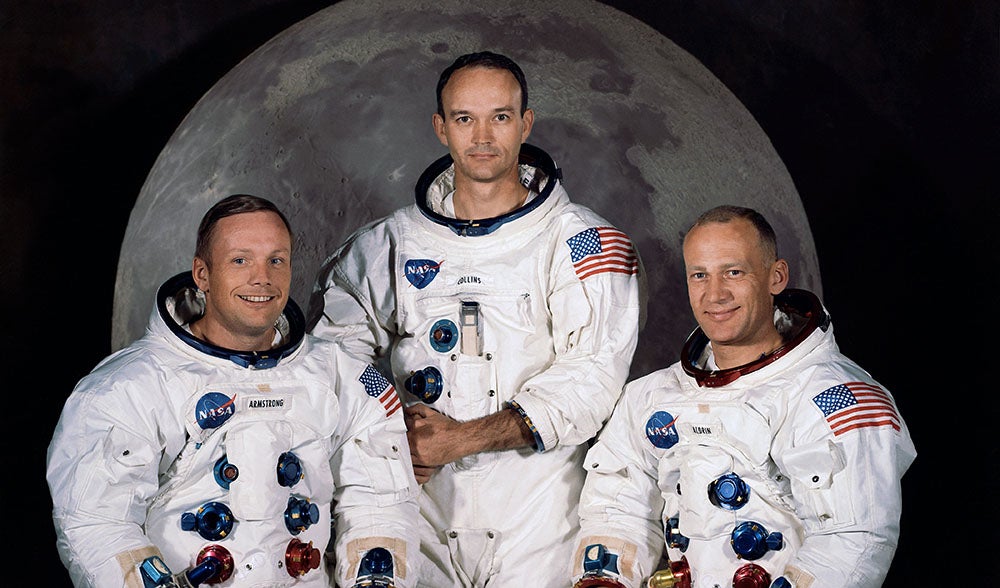
The Apollo 11 crew: Neil Armstrong, Michael Collins, Edwin “Buzz” Aldrin. (NASA)
By 1961, the Russians were far ahead. They had been the first to put a satellite into earth orbit in 1957 with !!!error: Indecipherable SUB-paragraph formatting!!! , and were the first to put a man into space when cosmonaut !!!error: Indecipherable SUB-paragraph formatting!!! orbited the Earth on April 12, 1961. Six weeks after Gagarin circled the plane, President Kennedy made a historic speech that galvanized the United States into action and challenged the nation to be the first to put a man on the moon. Though Kennedy and NASA trumpeted the scientific gains from such an achievement, he made it clear in a !!!error: Indecipherable SUB-paragraph formatting!!! on September 12, 1962 at Rice University in Houston that beating the Russians to the Moon was as much a matter of national security as it was a matter of scientific discovery.
We set sail on this new sea because there is new knowledge to be gained, and new rights to be won, and they must be won and used for the progress of all people. For space science, like nuclear science and all technology, has no conscience of its own. Whether it will become a force for good or ill depends on man, and only if the United States occupies a position of pre-eminence can we help decide whether this new ocean will be a sea of peace or a new terrifying theater of war.
Following President Kennedy’s declaration that America would go to the Moon, NASA began working on the technological means to get there. !!!error: Indecipherable SUB-paragraph formatting!!! , which was currently underway and carried a single astronaut to space, was followed by !!!error: Indecipherable SUB-paragraph formatting!!! , which carried two astronauts and put the US ahead of the Russians for good in the race to the Moon. The !!!error: Indecipherable SUB-paragraph formatting!!! which followed was be the most ambitious yet, and the first flight of an unmanned Apollo rocket took place in 1966. The first manned flight was to have been !!!error: Indecipherable SUB-paragraph formatting!!! , but a fire in the Command Module during testing on February 21, 1967 killed the three astronauts onboard. Following modifications to the spacecraft, !!!error: Indecipherable SUB-paragraph formatting!!! carried the first Apollo astronauts into space took place the following year. Subsequent missions served to test systems for the voyage and landing, and !!!error: Indecipherable SUB-paragraph formatting!!! came within 50,000 feet of the lunar surface.
Apollo 11 was the fifth manned mission of the program, and was launched atop the mighty three-stage !!!error: Indecipherable SUB-paragraph formatting!!! rocket, which carried the !!!error: Indecipherable SUB-paragraph formatting!!! and !!!error: Indecipherable SUB-paragraph formatting!!! into orbit around the Moon. Astronauts !!!error: Indecipherable SUB-paragraph formatting!!! , !!!error: Indecipherable SUB-paragraph formatting!!! and !!!error: Indecipherable SUB-paragraph formatting!!! began orbiting the Moon on July 19, and completed 30 orbits before Armstrong and Aldrin descended to the Moon’s surface on July 20 while Collins remained in orbit in the Command Module. The Lunar Module, piloted by Armstrong, touched down on the Moon at 20:17:40 !!!error: Indecipherable SUB-paragraph formatting!!! on Sunday, July 20 and, after completing the landing checklist, Armstrong made the first of two momentous radio calls: “Houston, Tranquility Base here. The Eagle has landed.”At 02:39 UTC on Monday July 21, 1969, Armstrong began his descent of the Lander’s ladder and made the first human footprint on the Moon. As he did so, he made second historic radio call: “That’s one small step for [a] man, one giant leap for mankind.” Aldrin then followed Armstrong down the ladder, and the pair spent about two-and-a-half hours exploring the area around the Lander and collected roughly 48 pounds of rocks and other lunar material.
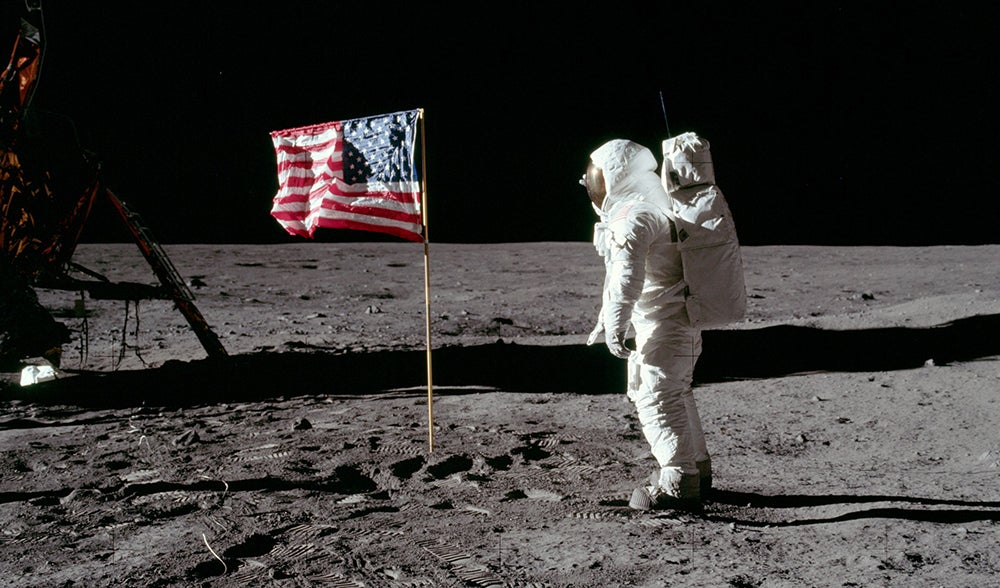
Astronaut Edwin “Buzz” Aldrin salutes the American flag at Tranquility Base on the Moon. (NASA)
The asternauts also planted an American flag on the Moon as a symbol of American achievement. It was the first of an eventual six flags that were placed by subsequent Apollo missions. But that flag carried a message of both victory in the Space Race and a tacit sense of ownership of the Moon. The Russians eventually abandoned their attempts to reach the Moon, and instead focused their their efforts on maintaining a manned presence in Earth orbit. After roughly 22 hours on the Moon’s surface, Armstrong and Aldrin climbed aboard the Lunar Module and blasted off for a rendezvous with Collins and the Command Module. The three astronauts then turned back toward Earth, and splashed down in the Pacific Ocean on July 24. There would be six more Apollo missions to the Moon, including the ill-fated
!!!error: Indecipherable SUB-paragraph formatting!!!
mission which did not land on the Moon yet safely returned the astronauts to Earth. The final flight of the Apollo program was
!!!error: Indecipherable SUB-paragraph formatting!!!
in 1972. After Apollo 17, the remaining Apollo hardware was used for the
!!!error: Indecipherable SUB-paragraph formatting!!!
and
!!!error: Indecipherable SUB-paragraph formatting!!!
projects.
!!! UNKNOWN CONTENT TYPE !!!

(US Air Force)
July 17, 1989 – The first flight of the Northrop Grumman B-2 Spirit. Though the B-2 looks like something from the pages of science fiction, the flying wing is nothing new. !!!error: Indecipherable SUB-paragraph formatting!!! began experimenting with long-range flying wing bombers during WWII, first with the !!!error: Indecipherable SUB-paragraph formatting!!! , with took its maiden flight in 1946, and then with the jet-powered !!!error: Indecipherable SUB-paragraph formatting!!! the following. Though the flying wing idea, which sought to remove the drag produced by the fuselage of a traditional aircraft, never caught on—or was killed for political reasons—it was not forgotten.
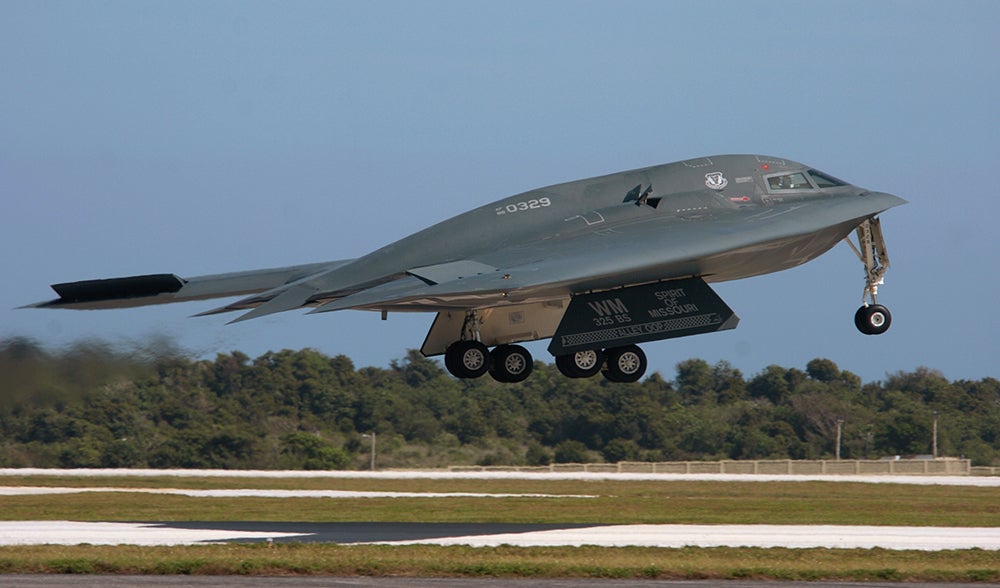
The B-2 Spirit of Missouri from the 509th Bomb Wing at Whiteman Air Force Base, Missouri takes off from Andersen Air Force Base in Guam. (US Air Force)
In 1979, the US Air Force initiated the
!!!error: Indecipherable SUB-paragraph formatting!!!
(ATB) program to find a replacement for the venerable
!!!error: Indecipherable SUB-paragraph formatting!!!
. The new bomber would also take advantages of advances in
!!!error: Indecipherable SUB-paragraph formatting!!!
which, while not making the aircraft invisible to radar, would make it practically undistinguishable from other radar clutter. The original concepts of stealth technology had been developed by Lockheed, and they proved the viability of an “invisible” aircraft with the super-secret
!!!error: Indecipherable SUB-paragraph formatting!!!
program. They followed that with the successful development of the
!!!error: Indecipherable SUB-paragraph formatting!!!
, which first flew in 1981. Stealth had become a reality, and it would become an integral element of any future bomber or fighter development program.

The Northrop Tacit Blue technology demonstrator, which one Northrop engineer called “arguably the most unstable aircraft man had ever flown.” (US Air Force)
As the ATB program progressed, the Air Force took proposals from defense contractors for the new bomber and narrowed their selection down to proposals from Northrop/Boeing, codenamed “Senior Ice,” and a team from Lockheed/Rockwell, whose project was codenamed “Senior Peg.” Both groups suggested a flying wing design and, in October 1981, the Air Force selected Northrop’s entry. Unlike the flat, faceted shapes of the earlier Have Blue and F-117 designs, advances in computer aided design in the 1980s now allowed for similar radar deflection capabilities with a curved surface, called continuous curvature, which was originally tested on Northrop’s !!!error: Indecipherable SUB-paragraph formatting!!! aircraft. Gone were the sharp angles and flat panels, replaced by a gracefully rounded fuselage centered in a wing swept at 34.74 degrees. And, at 172 feet, the B-2's wingspan matches that of the earlier Northrop flying wings. Four !!!error: Indecipherable SUB-paragraph formatting!!! turbofans buried deep inside the fuselage give the Spirit a maximum speed of Mach 0.95, and the B-2 can carry an estimated 50,000 pounds of nuclear or conventional weapons inside two internal bomb bays. The !!!error: Indecipherable SUB-paragraph formatting!!! (RCS) of the Spirit is just 1.1 square feet for an aircraft with a wing area of over 5,000 square feet. By 1989, it is estimated that the US spent $23 billion developing the new bomber.
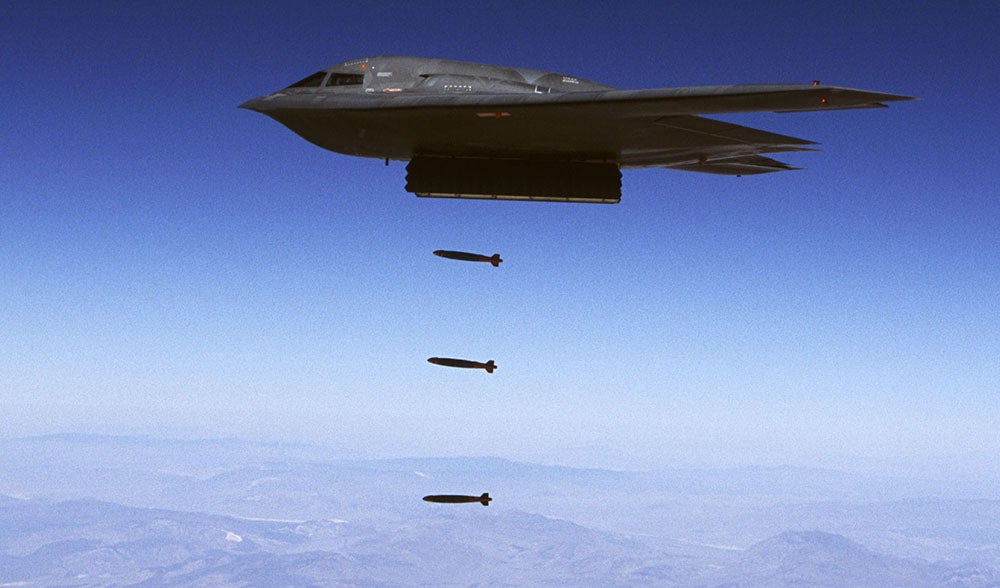
A B-2 drops JDAM bombs during a test at the Utah Testing and Training Range. (US Air Force)
Though the B-2 was originally conceived as a deep penetration bomber, meant to fly undetected into the Soviet Union to deploy nuclear weapons, the Spirit saw its first action in 1999 as part of !!!error: Indecipherable SUB-paragraph formatting!!! in the former Yugoslavia and became the first US warplane to deploy the !!!error: Indecipherable SUB-paragraph formatting!!! satellite-guided bomb. B-2s saw additional action in !!!error: Indecipherable SUB-paragraph formatting!!! and Afghanistan and, during !!!error: Indecipherable SUB-paragraph formatting!!! , B-2s flew from Whiteman AFB in Missouri to bomb targets in Afghanistan, a 40 hour flight with aerial refueling. The B-2 has also flown missions against !!!error: Indecipherable SUB-paragraph formatting!!! militants in Libya and Syria. A total of 21 Spirits have been built since they entered service in 1997 (one was lost to a crash in 2008), but the Air Force plans to retire them by 2032 to make way for their replacement by the Northrop B-21 Raider.
!!! UNKNOWN CONTENT TYPE !!!
Short Takeoff
!!! UNKNOWN CONTENT TYPE !!!
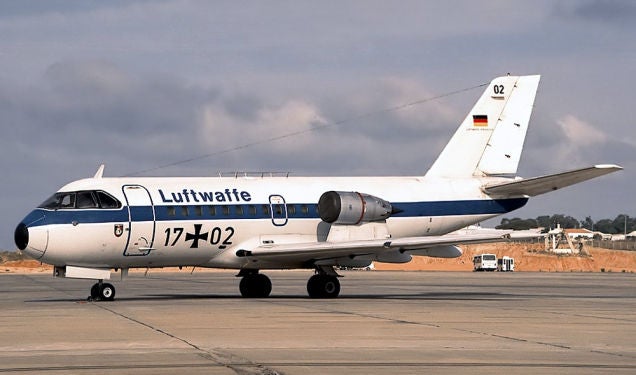 !!!CAPTION ERROR: MAY BE MULTI-LINE OR CONTAIN LINK!!!
!!!CAPTION ERROR: MAY BE MULTI-LINE OR CONTAIN LINK!!!
July 14, 1971 – The first flight of the VFW-Fokker 614, a twin-engined medium-range jetliner designed and built in West Germany as a replacement for the !!!error: Indecipherable SUB-paragraph formatting!!! and notable for the placement of its two engines in pods above the wings. The location of the two !!!error: Indecipherable SUB-paragraph formatting!!! turbofan engines avoided the added structural weight of attaching them to the rear fuselage, and also helped eliminate the possibility of ingestion of debris common in underwing mountings. Due to cost and development delays, only a handful were produced before the project was canceled in 1977. Unfinished aircraft were broken up, and the remainder were bought back by the manufacturer.
!!! UNKNOWN CONTENT TYPE !!!
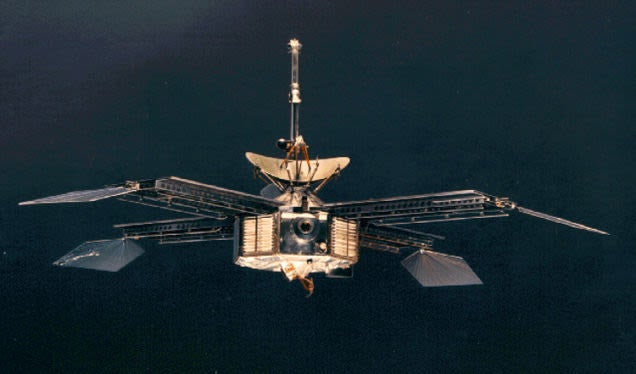
(NASA)
July 14, 1965 – Mariner 4 flies past Mars. Mariner 4 was part of NASA’s !!!error: Indecipherable SUB-paragraph formatting!!! that explored planets in the Solar System by flying past to make scientific observations and return photographs. Mariner 4 was launched from !!!error: Indecipherable SUB-paragraph formatting!!! on November 28, 1964 and, after its arrival at Mars, it sent back the first images ever returned from deep space. The views of a cratered, seemingly lifeless world changed many scientific opinions previously held about the Red Planet. Mariner 4 collected data for two days as it flew past Mars, and remains in its heliocentric orbit following termination of communications on December 21, 1967.
!!! UNKNOWN CONTENT TYPE !!!

(UK Government)
July 14, 1948 – The first flight of the Supermarine Seagull, an amphibious air-sea rescue and maritime reconnaissance aircraft and the last propeller plane built by the famed !!!error: Indecipherable SUB-paragraph formatting!!! company. As the name Supermarine suggests, the company got its start making floatplanes, and became famous by winning the !!!error: Indecipherable SUB-paragraph formatting!!! seaplane races in 1927, 1929 and 1931. Supermarine’s first landplane was the remarkable !!!error: Indecipherable SUB-paragraph formatting!!! , they produced the Royal Navy’s first jet fighter, the !!!error: Indecipherable SUB-paragraph formatting!!! , and followed that with the more advanced !!!error: Indecipherable SUB-paragraph formatting!!! and !!!error: Indecipherable SUB-paragraph formatting!!! . Work on the !!!error: Indecipherable SUB-paragraph formatting!!! -powered Seagull began late in WWII to develop a catapult-launched amphibian to replace the !!!error: Indecipherable SUB-paragraph formatting!!! and !!!error: Indecipherable SUB-paragraph formatting!!! . However, by 1950, when the Seagull was to have entered service, its role had been taken over by helicopters and only two prototypes were built. Supermarine was incorporated into the !!!error: Indecipherable SUB-paragraph formatting!!! in 1960.
!!! UNKNOWN CONTENT TYPE !!!
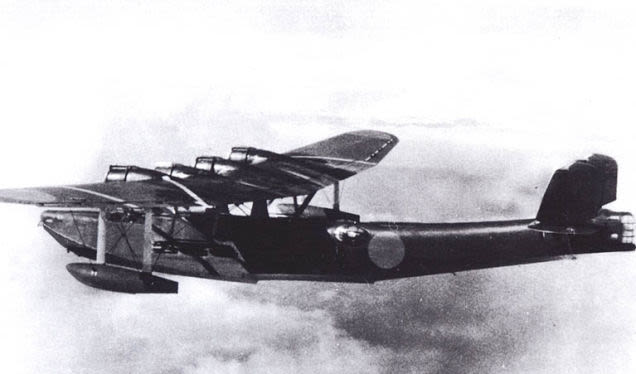
(Author unknown)
July 14, 1936 – The first flight of the Kawanishi H6K, a maritime patrol flying boat built for the Japanese Navy. Influenced by the work of the !!!error: Indecipherable SUB-paragraph formatting!!! in Ireland and the earlier !!!error: Indecipherable SUB-paragraph formatting!!! , itself a license-built and enlarged version of the !!!error: Indecipherable SUB-paragraph formatting!!! , the H6K entered service in 1938 and saw service in the !!!error: Indecipherable SUB-paragraph formatting!!! and WWII. Though vulnerable to modern fighters flown by the Allies during WWII, the H6K remained in service until the Japanese surrender in 1945, but was replaced in front line service by the more modern !!!error: Indecipherable SUB-paragraph formatting!!! . A total of 215 were produced.
!!! UNKNOWN CONTENT TYPE !!!
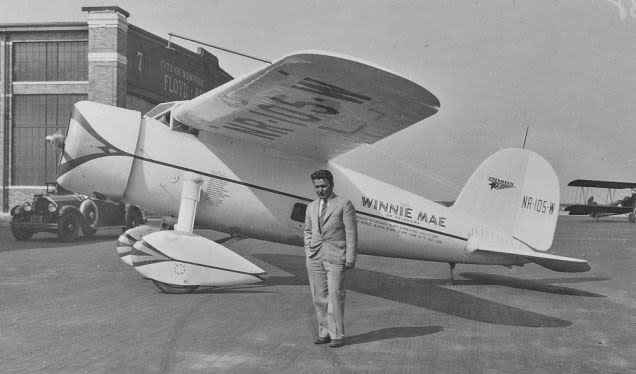
(Rudy Arnold)
July 14, 1933 – Wiley Post departs on the first solo circumnavigation of the globe. Post had previously made a trip around the world in 1931 with navigator !!!error: Indecipherable SUB-paragraph formatting!!! , finishing the trip in eight days and beating the previous record of 21 days held by the airship !!!error: Indecipherable SUB-paragraph formatting!!! (LZ 127). For his second flight, Post set off alone from !!!error: Indecipherable SUB-paragraph formatting!!! , again in his !!!error: Indecipherable SUB-paragraph formatting!!! Winnie Mae and, using an autopilot and compass in place of a navigator, completed the journey in just over seven days, breaking his own record. Post was greeted in New York by a throng of 50,000 people, and the Winnie Mae now resides in the Smithsonian’s !!!error: Indecipherable SUB-paragraph formatting!!! in northern Virginia.
!!! UNKNOWN CONTENT TYPE !!!
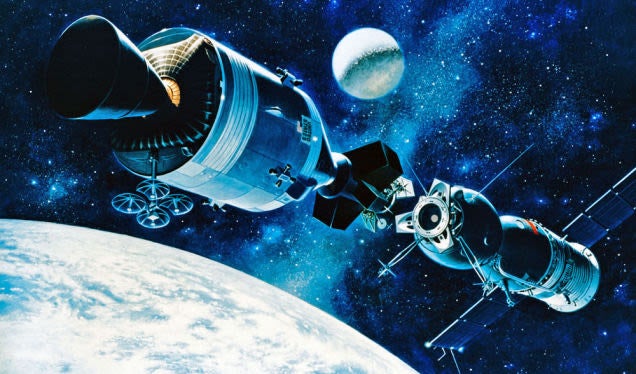
(NASA)
July 15, 1975 – The launch of the Apollo-Soyuz Test Project.
As a symbol of the policy of
!!!error: Indecipherable SUB-paragraph formatting!!!
pursued by the US and the Soviet Union beginning in 1969, the Test Project was the first joint space program initiated by the two
!!!error: Indecipherable SUB-paragraph formatting!!!
adversaries. Both the
!!!error: Indecipherable SUB-paragraph formatting!!!
and
!!!error: Indecipherable SUB-paragraph formatting!!!
capsules launched on the same date and rendezvoused in space, with the three astronauts and two cosmonauts joining hands and passing between the two docked spacecraft. The crews then carried out joint scientific experiments. The ships remained docked for 44 hours before separating and returning safely to Earth. Today, Russia and the United States continue their partnership in space aboard the International Space Station.
!!! UNKNOWN CONTENT TYPE !!!
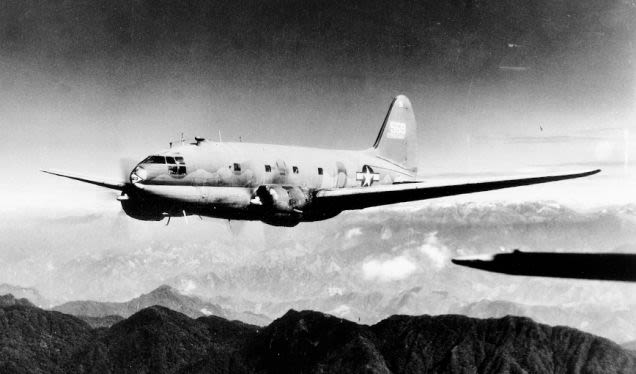
(US Air Force)
July 15, 1942 – The US Army Air Forces flies its first supply mission from India to China over the Himalayas.
In the early days of the fight against Japanese expansion in the Pacific, the only way to resupply Nationalist Chinese and American troops fighting in China was by flying over the eastern
!!!error: Indecipherable SUB-paragraph formatting!!!
, which pilots referred to as “The Hump.” The dangerous and arduous supply missions, flown first by
!!!error: Indecipherable SUB-paragraph formatting!!!
and later by the untested
!!!error: Indecipherable SUB-paragraph formatting!!!
, eventually ferried 650,000 tons of supplies against the loss of 594 aircraft and nearly 1,700 personnel.
!!! UNKNOWN CONTENT TYPE !!!
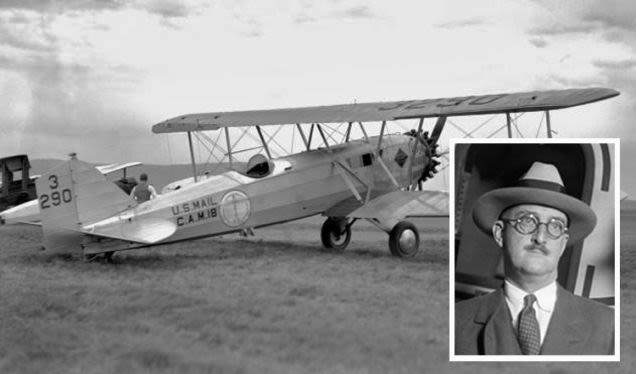
(Los Angeles Times; portrait author unknown)
July 15, 1916 – William Boeing founds the Pacific Aero Products Company, the forerunner of the Boeing Airplane Company
. After finding success in the lumber industry, Boeing turned his attention to aircraft, going into business with
!!!error: Indecipherable SUB-paragraph formatting!!!
to found the Pacific Aero Products Group and building their first aircraft, the
!!!error: Indecipherable SUB-paragraph formatting!!!
. With America’s entry into WWI, Boeing changed the name to Boeing Airplane Company and built 50 aircraft for the US Navy. Following the war, Boeing concentrated on commercial aircraft, and built an airmail operation that eventually became United Airlines. William Boeing left the company in 1937, but the company he founded went on to become one of the largest manufacturers of civilian and military aircraft in the world.
!!! UNKNOWN CONTENT TYPE !!!
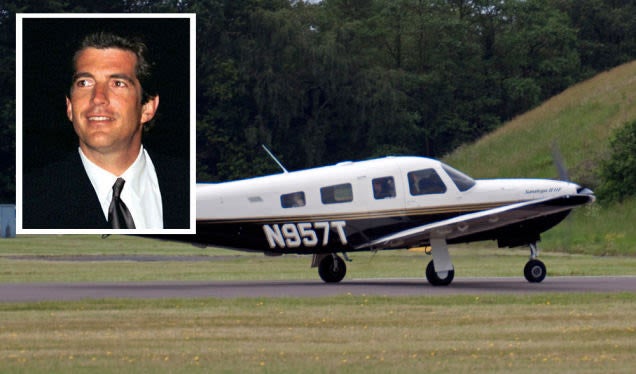 !!!CAPTION ERROR: MAY BE MULTI-LINE OR CONTAIN LINK!!!
!!!CAPTION ERROR: MAY BE MULTI-LINE OR CONTAIN LINK!!!
July 16, 1999 – The death of John F. Kennedy, Jr,
the only surviving son of US President
!!!error: Indecipherable SUB-paragraph formatting!!!
and First Lady
!!!error: Indecipherable SUB-paragraph formatting!!!
. Kennedy had departed Essex County Airport in New Jersey in his
!!!error: Indecipherable SUB-paragraph formatting!!!
(N9253N) for a flight along the Connecticut coastline to Martha’s Vineyard when the plane crashed into the Atlantic Ocean, killing Kennedy along with his wife
!!!error: Indecipherable SUB-paragraph formatting!!!
and her sister Lauren. The National Transportation Safety Board
!!!error: Indecipherable SUB-paragraph formatting!!!
the probable cause as pilot error, saying that Kennedy likely became disoriented while flying over water at night. Kennedy was not qualified for instrument flight conditions and, while conditions at the time did not require IFR flying, other pilots cited the lack of a visual horizon due to hazy conditions.
!!! UNKNOWN CONTENT TYPE !!!
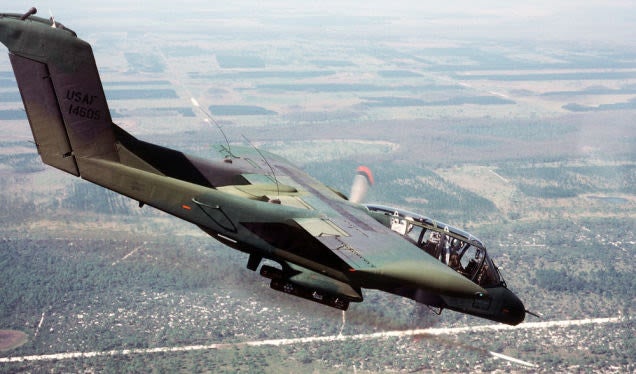
(US Air Force)
July 16, 1965 – The first flight of the North American Rockwell OV-10 Bronco,
a lightweight, STOL aircraft developed for the US Army, Air Force and Marine Corps for observation, forward air control, helicopter escort, armed reconnaissance, gunfire spotting, utility and ground attack. Despite its diminutive size, the Bronco can carry up to 6,000 pounds of external stores, as well as paratroops or stretchers, and its turboprop engines allow for at least three hours of loiter time over the battlefield. The Bronco first saw service with the US Marine Corps in Vietnam, and has since served both the US Air Force and US Navy. In civilian use, the Bronco has served NASA and as a firefighting aircraft, and military versions have recently returned to the skies over Afghanistan and Syria in the fight against
!!!error: Indecipherable SUB-paragraph formatting!!!
.
!!! UNKNOWN CONTENT TYPE !!!
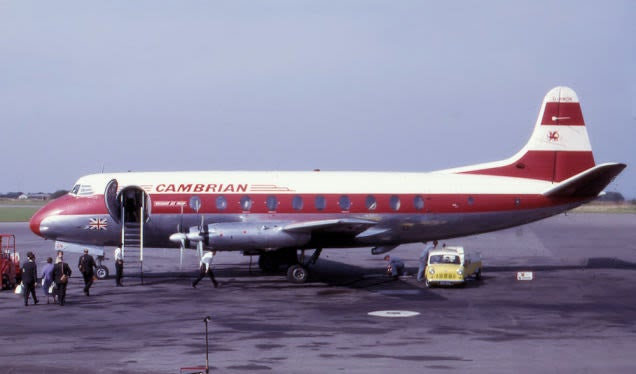 !!!CAPTION ERROR: MAY BE MULTI-LINE OR CONTAIN LINK!!!
!!!CAPTION ERROR: MAY BE MULTI-LINE OR CONTAIN LINK!!!
July 16, 1948 – The first flight of the Vickers Viscount, a medium range, pressurized airliner and the first airliner in the world to employ turboprop engines. Development of the Viscount resulted from the work of the !!!error: Indecipherable SUB-paragraph formatting!!! , a group founded to promote civilian aviation in England following WWII. The Viscount entered service with !!!error: Indecipherable SUB-paragraph formatting!!! (BEA) in 1953 and became one of the most popular and successful post-war transport and cargo aircraft. It provided the world’s first turboprop-powered passenger service and proving so successful that 160 aircraft had been ordered by only the second year of operations. A total of 445 were produced from 1948-1963, and the type was finally retired in 2008.
!!! UNKNOWN CONTENT TYPE !!!
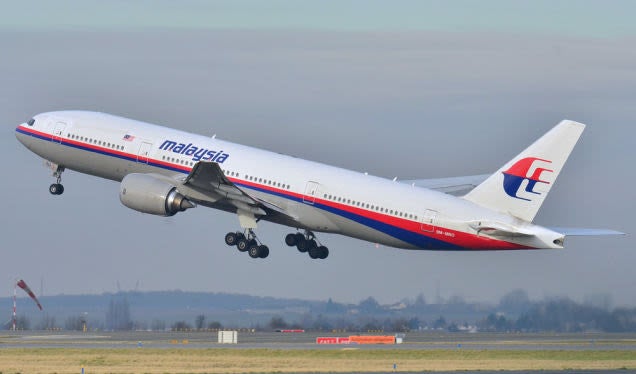 !!!CAPTION ERROR: MAY BE MULTI-LINE OR CONTAIN LINK!!!
!!!CAPTION ERROR: MAY BE MULTI-LINE OR CONTAIN LINK!!!
July 17, 2014 – Malaysia Airlines Flight 17 is shot down over eastern Ukraine.
Just four months after the unexplained disappearance of
!!!error: Indecipherable SUB-paragraph formatting!!!
over the southern Indian Ocean, Malaysian Airlines was again hit with tragedy when a
!!!error: Indecipherable SUB-paragraph formatting!!!
(9M-MRO) was shot down by an antiaircraft missile over war-torn eastern Ukraine, killing all 298 passengers and crew. Much argument and acrimony remains over who is responsible for firing the Russian-made
!!!error: Indecipherable SUB-paragraph formatting!!!
missile. The Ukrainian government blames Russian-backed separatists, while the separatists blame the Ukranian government, and both sides in the ongoing conflict have the weapons necessary to bring down an aircraft cruising at 33,000 feet. Despite an investigation by the Dutch government, it may never be ascertained who fired the missile that destroyed the airliner, though an international team of investigators have
!!!error: Indecipherable SUB-paragraph formatting!!!
the finger firmly at Russian forces operating in the area.
!!! UNKNOWN CONTENT TYPE !!!
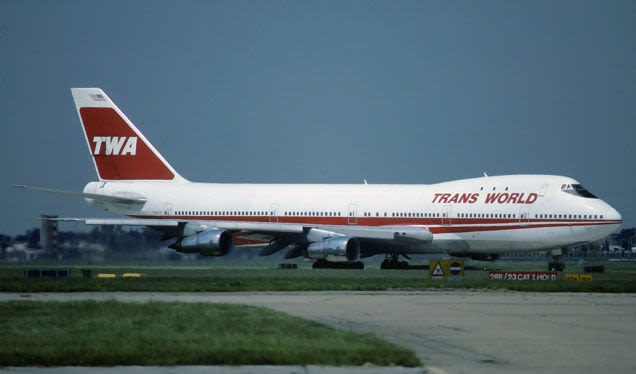 !!!CAPTION ERROR: MAY BE MULTI-LINE OR CONTAIN LINK!!!
!!!CAPTION ERROR: MAY BE MULTI-LINE OR CONTAIN LINK!!!
July 17, 1996 – A midair explosion destroys TWA Flight 800.
TWA 800 was a regularly scheduled flight from New York to Rome when the
!!!error: Indecipherable SUB-paragraph formatting!!!
(N91339) exploded in midair shortly after takeoff, killing all 230 passengers and crew. No distress call was made prior to the explosion, and cockpit conversations appeared to be normal, except that just before the explosion the captain remarked about a “crazy fuel flow indicator.” In one of the most exhaustive investigations ever carried out, as much debris as could be found was brought to the surface and assembled in a hangar in Calverton, NY. After a four-year investigation, the final
!!!error: Indecipherable SUB-paragraph formatting!!!
pointed to the likely cause being the explosion of a fuel/air mixture in the center fuel tank that was ignited by an undetermined short circuit. Despite this explanation, conspiracy theories abound to this day, one of the most persistent being that the airliner was shot down by a missile fired either by the US Navy or by terrorists in a boat or on shore. However, evidence for these theories remains circumstantial.
!!! UNKNOWN CONTENT TYPE !!!
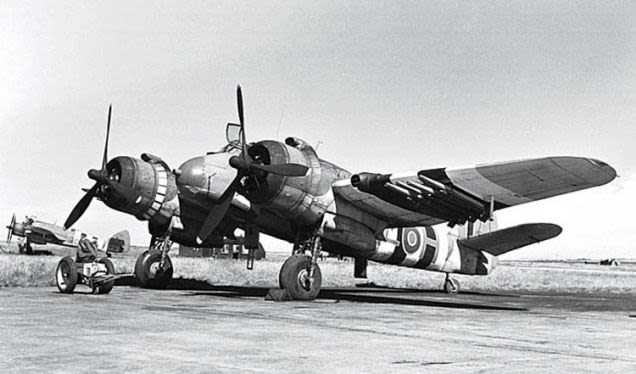
(Canadian Forces)
July 17, 1939 – The first flight of the Bristol Beaufighter,
a multi-role fighter bomber developed during WWII as a development of the
!!!error: Indecipherable SUB-paragraph formatting!!!
torpedo bomber. Originally conceived as a heavy fighter, the Beaufighter was subsequently developed into a night fighter and maritime strike and ground attack aircraft. Entering service at almost the same time as the first airborne radar sets, the Beaufighter’s large nose was large enough to accommodate the bulky radar sets of the time, and its heavy armament of four 20 mm cannons made it ideal to defend against German bombers. The Beaufighter also served RAF Coastal Command and in the Pacific, and flew as late as 1948 for the Israeli Air Force. Nearly 6,000 Beaufighters were produced from 1940-1946.
!!! UNKNOWN CONTENT TYPE !!!
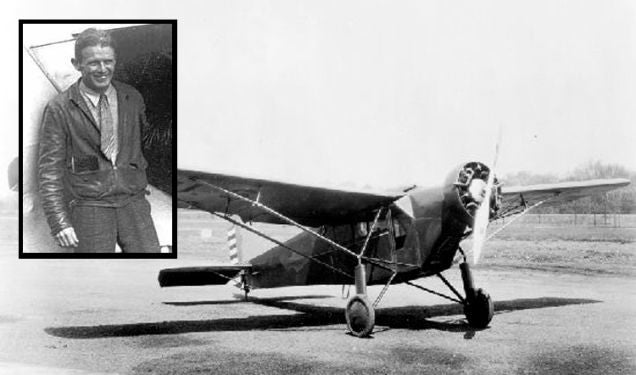
(US Air Force)
July 17, 1938 – Douglas “Wrong Way” Corrigan departs from Floyd Bennett Field and flies to Ireland. Corrigan worked as an aircraft constructor in San Diego before taking up flying and, inspired by !!!error: Indecipherable SUB-paragraph formatting!!! solo crossing of the Atlantic Ocean 1937, he decided to emulate the feat. Corrigan failed to gain permission for his flight and, after filing a flight plan for California, he took off from Floyd Bennett Field in New York and instead turned his !!!error: Indecipherable SUB-paragraph formatting!!! monoplane east and flew to Ireland. After landing in Ireland, Corrigan claimed that a navigational error led to his wrong-way flight, but his plane was nevertheless modified to carry extra fuel for the journey. Corrigan never admitted that his mistake was intentional, and he and his plane returned to the US on the steamship !!!error: Indecipherable SUB-paragraph formatting!!! .
!!! UNKNOWN CONTENT TYPE !!!
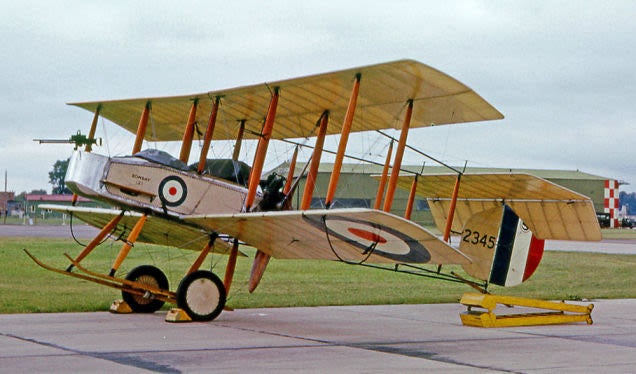 !!!CAPTION ERROR: MAY BE MULTI-LINE OR CONTAIN LINK!!!
!!!CAPTION ERROR: MAY BE MULTI-LINE OR CONTAIN LINK!!!
July 17, 1914 – The first flight of the Vickers F.B.5,
a two-seat pusher biplane and the first purpose-built fighter plane ever produced. Known familiarly as the Gunbus, the F.B.5 was powered by a single
!!!error: Indecipherable SUB-paragraph formatting!!!
9-cylinder engine which gave it a top speed of 70 mph and was armed with a single 7.7mm
!!!error: Indecipherable SUB-paragraph formatting!!!
in the forward observer’s cockpit. The F.B.5 entered service in November 1914 and claimed its first victory over a German
!!!error: Indecipherable SUB-paragraph formatting!!!
monoplane. By 1915, the F.B.5 equipped the world’s first dedicated fighter squadron. The Gunbus was very quickly outclassed by newer German designs, and was retired to serve as a trainer. A total of 224 were built.
!!! UNKNOWN CONTENT TYPE !!!
Connecting Flights
!!! UNKNOWN CONTENT TYPE !!!
!!! UNKNOWN CONTENT TYPE !!!
!!! UNKNOWN CONTENT TYPE !!!
!!! UNKNOWN CONTENT TYPE !!!
!!! UNKNOWN CONTENT TYPE !!!
If you enjoy these Aviation History posts, please let me know in the comments. And if you missed any of the past articles, you can find them all at
!!!error: Indecipherable SUB-paragraph formatting!!!
. You can also find more stories about aviation, aviators and airplane oddities at
!!!error: Indecipherable SUB-paragraph formatting!!!
.
!!! UNKNOWN CONTENT TYPE !!!
 RamblinRover Luxury-Yacht
> ttyymmnn
RamblinRover Luxury-Yacht
> ttyymmnn
07/17/2018 at 12:47 |
|
I’m a big Wiley Post fan.
 ttyymmnn
> RamblinRover Luxury-Yacht
ttyymmnn
> RamblinRover Luxury-Yacht
07/17/2018 at 12:50 |
|
He was a hell of a guy. I’d love to sit down and have a beer or two with him.
 RamblinRover Luxury-Yacht
> ttyymmnn
RamblinRover Luxury-Yacht
> ttyymmnn
07/17/2018 at 12:54 |
|
Related to another one of your items,
IIRC the Time-Life book on China-Burma-India has some interesting info on the Over The Hump operations. Might have also been some detail in Tuchmann’s book on Stilwell, though it’s been a while since I read it.
 ttyymmnn
> RamblinRover Luxury-Yacht
ttyymmnn
> RamblinRover Luxury-Yacht
07/17/2018 at 13:00 |
|
I didn’t know that Tuchman had written a book on Stilwell. I’ve read just about everything else she’s written. I’ll have to check it out.
 RamblinRover Luxury-Yacht
> ttyymmnn
RamblinRover Luxury-Yacht
> ttyymmnn
07/17/2018 at 13:05 |
|
She’s sometimes wrong or overly simplistic on motives, but she rarely tells a bad story. A cousin of my dad’s is a huge Tuchman fan and didn’t know either, so when I mentioned I had
Stilwell and the American Experience in China
he started trying to buy it off me.
 ttyymmnn
> RamblinRover Luxury-Yacht
ttyymmnn
> RamblinRover Luxury-Yacht
07/17/2018 at 14:13 |
|
The March of Folly is the book that got me hooked on history. My favorite, though, is A Distant Mirror . Not that I’m any sort of professional historian, but it is always a balancing act between giving to much information so as to make it boring while giving enough so as to keep it from being shallow or, as you say, simplistic. To me, history is all about context, which is why I try to frame all of my long articles with some historical context rather than just launching into talking about an airplane or a person. History doesn’t happen in a vacuum.
 Derpwagon
> ttyymmnn
Derpwagon
> ttyymmnn
07/17/2018 at 16:11 |
|
Broncooooo! Love those birds.
I find myself skimming these looking for radial engined aircraft and flying boats.
 ttyymmnn
> Derpwagon
ttyymmnn
> Derpwagon
07/17/2018 at 16:56 |
|
Jets are cool, but there’s nothing like the sound of those big radials banging away.
 John Norris (AngryDrifter)
> ttyymmnn
John Norris (AngryDrifter)
> ttyymmnn
07/17/2018 at 21:44 |
|
 ttyymmnn
> John Norris (AngryDrifter)
ttyymmnn
> John Norris (AngryDrifter)
07/17/2018 at 21:49 |
|
That’s awesome. I’ve never seen that arrangement before. Thanks!
 f86sabre
> ttyymmnn
f86sabre
> ttyymmnn
07/17/2018 at 22:02 |
|
I didn’t realize that they moved the Winnie Mae over to hazy. Ive always liked that plane.
 ttyymmnn
> f86sabre
ttyymmnn
> f86sabre
07/17/2018 at 22:27 |
|
Here’s a picture of it in front of the Dash 80. My last visit was in 2014, and I don’t remember seeing it. But then again, I wasn’t really looking for it.

 pip bip - choose Corrour
> ttyymmnn
pip bip - choose Corrour
> ttyymmnn
07/18/2018 at 05:57 |
|
TWA800 was definitely shot down by the U.S. navy.
 f86sabre
> ttyymmnn
f86sabre
> ttyymmnn
07/18/2018 at 17:39 |
|
Well, there you go.